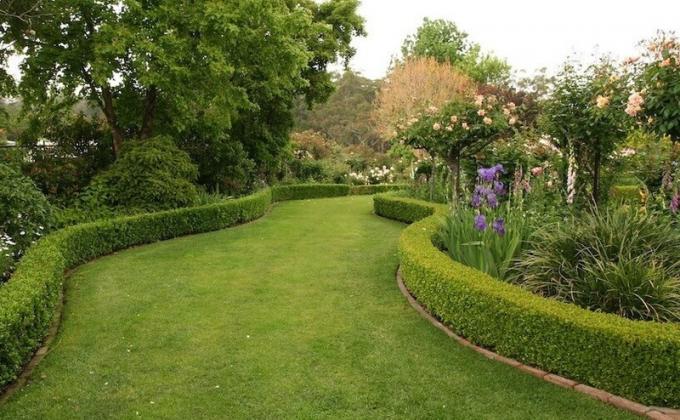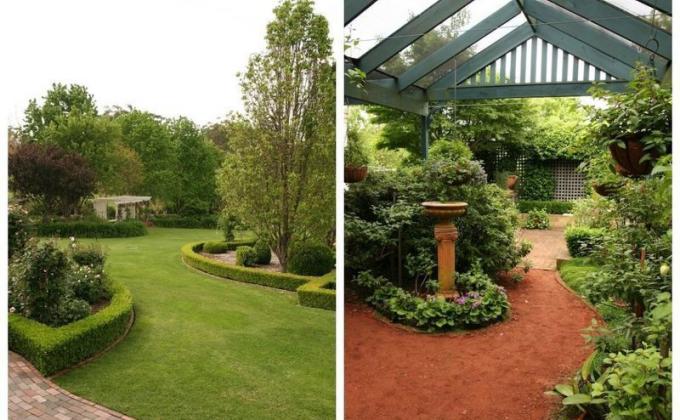
This large garden in north Sydney was designed by Julie Cartledge. For her, landscape design is not just a job, but a way to express herself through creativity. Julie is now focused on arranging large spaces, which helps her to look at her craft more broadly.
Visual effects for the garden
Effect # 1. An Intriguing Perspective
Effect # 2. Repetition of plants
Effect # 3. Zone alternation
Effect # 4. Framing the aisles
Effect # 5. Simple geometry
Effect number 6. Multi-layered space
Effect # 7. Wild Corners
Effect number 8. Exotic
Effect number 9. Asymmetry
Effect # 10. Color contrast
Effect number 11. Vertical gardening
Today we are publishing 11 visual effects from Julie Cartlidge, using the example of a garden that takes pride of place in her portfolio.
Effect # 1. An Intriguing Perspective
Otherwise, a path that goes out of sight. Large gardens are only good if you use vistas that encourage you to follow the paths and discover the area. In a word, travel. On small plots up to 2 acres, the creation of such effects is impossible, but starting from 3-4 acres you have the opportunity to use the space in order to create a whole park.
Perspective is, first of all, intrigue. And landscape gardening art is a tool for its creation. The winding paths that narrow and widen create the effect of "fluidity" of the space, which allows you to perceive the garden as a place for interesting and new discoveries.
Effect # 2. Repetition of plants
Plant repetition is a key feature in this garden. Standard roses, topiary bushes, conifers of the same type are scattered throughout the garden and create a sense of the integrity of the image.
Effect # 3. Zone alternation
A large garden should also change the pace and mood. There should be a vegetable garden behind a large gazebo, a rose garden should begin immediately after the patio, and the lawns must be surrounded by shrubs or trees, and not just stunted plants.
Simply put, the garden should alternate between zones that contrast with each other.
Effect # 4. Framing the aisles
Pergolas, arches - all this is familiar to any gardener. But the framing of the aisle is not just a crossbar. It should create an effect of mystery, which is best suited to densely climbing plants, rather than miniature climbing roses.
Effect # 5. Simple geometry
When pruning plants, very often we try to create too complex structures. Or vice versa - limit yourself to three spherical plants in a row. The way out of this situation is simple geometry, which implies the presence of 1-2 large plants and 2-3 small, undersized plants in one composition.
Effect number 6. Multi-layered space
This effect can be easily explained using the example of installing ordinary benches. For example, you decide to put one near your house and the other somewhere in a shady part of the garden. With the first, everything is clear, but the second, as often happens, is placed with its back to the border of the site. That is, they are located around the perimeter. Layering can be achieved by arranging furniture around the center of the site, and not just around the edges. For example, then the bench will stand at the central lawn, and behind it there will be a path along which you can walk from the house to the end of the site and back.
Effect # 7. Wild Corners
Some parts of your garden must be left to self-support. This can be achieved using unpretentious plants.
This part, if desired, can be fenced off so that the growing plants do not interfere with the garden or decorative plantings.
Effect number 8. Exotic
Without exotic plants, shades, ornaments or just foreign traditions, the garden looks monotonous. Of course, if you want to create a reference Russian garden, you should refrain from exotic, but in most cases it only helps.
Effect number 9. Asymmetry
If you already have a flat path at your disposal, which in fact is already a perspective itself, then the landings can be organized according to the principle of asymmetry. But this does not mean that they are performed chaotically. Take a look at the photo below - there is a clear crop rotation with a slight difference, which makes the track more interesting. At the same time, only a few types of plants were used here, and not everything that came to hand.
You can create a similar composition by choosing plants with different crown shapes:
Conifers with a vertical crown shape
Compact trees with a globular crown
Healing Trees Silhouettes
Trees and shrubs with an openwork crown for decorating a summer cottage
Effect # 10. Color contrast
The greenery surrounding us in the garden definitely needs a contrasting material. At the same time, the tree does not always cope with its task, merging with the landscape. For these purposes, tile paving, clay sculptures, stone structures or painted wood are more suitable for you.
Effect number 11. Vertical gardening
It can be wall-mounted or suspended. The main thing is to raise it to the rank of a whole trend, allocate enough space and maintain a certain leaf. For example, futuristic, minimalistic or, as in the photo above, eco-style.









